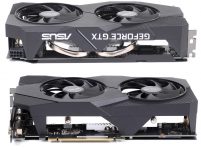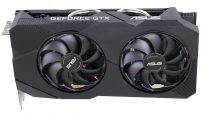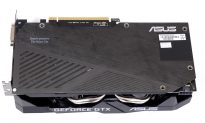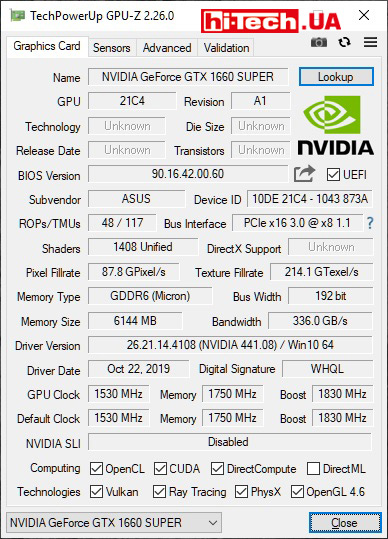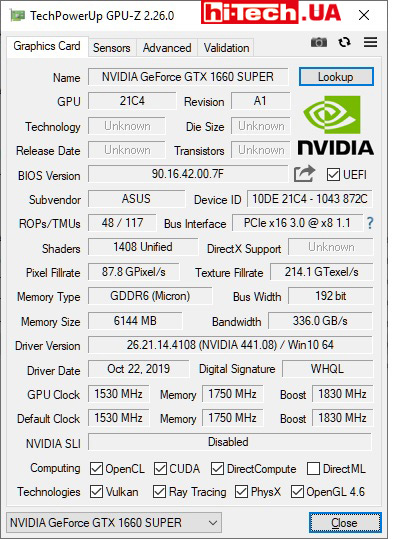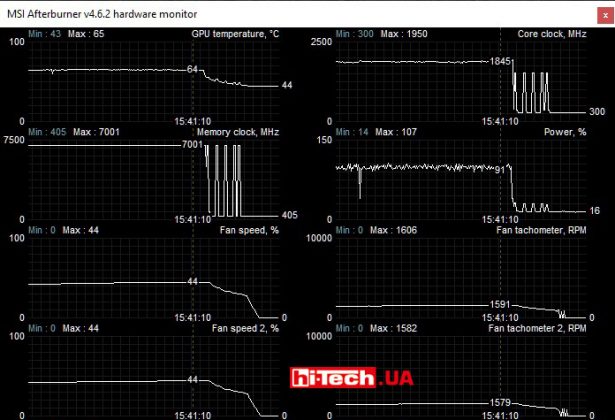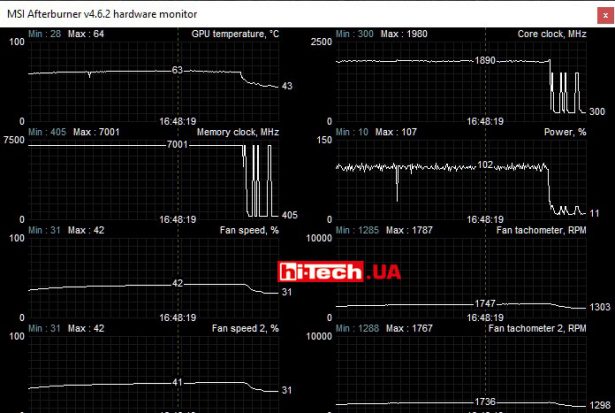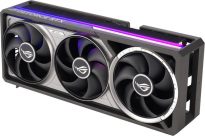ASUS Dual and TUF Gaming NVIDIA GTX 1660 Super video cards series test. What’s new in the “super” version?
08.11.19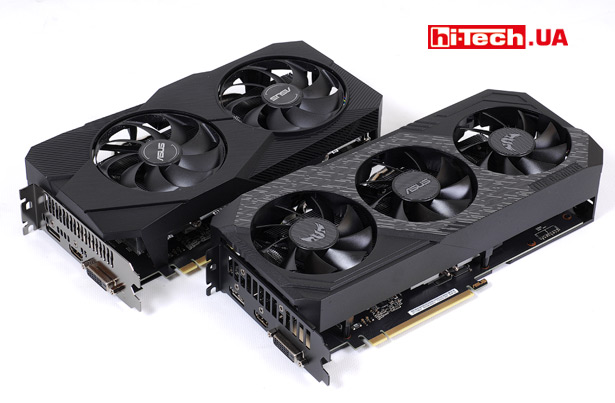
Due to increased competition from AMD, NVIDIA began to additionally hedge its bets and release slightly modified versions of its latest generation video cards based on the Turing architecture.
Such new products receive an additional prefix Super in the name.
The first “Super” video cards were NVIDIA GeForce RTX 2060 SUPER, RTX 2070 SUPER and RTX 2080 SUPER.
But recently the turn came to the more budget GTX 16XX series.
A week ago there were mid-class video cards NVIDIA GeForce GTX 1660 SUPER and GTX 1650 SUPER announced.
The heroes of this material are video cards based on the GTX 1660 SUPER.
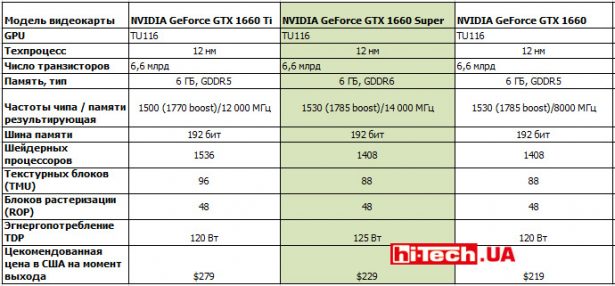
Comparison of reference characteristics of NVIDIA GeForce GTX 1660, GTX 1660 Super and GTX 1660 Ti video cards
As you can see from the comparison table, they are distinguished from “regular” GTX 1660 only by the use of a new type of video memory, GDDR 6.
Let us remind you once again that the prefix RTX (and not GTX) indicates the presence of tensor and RT cores on the video card. NVIDIA has made a very big bet on these technologies, but at the moment we would not call them fundamentally important. This is an interesting toolkit for experimentation.
We managed to get two GTX 1660 Super video cards for testing: the ASUS TUF Gaming X3 GeForce GTX 1660 SUPER OC with three fans and the two-fan ASUS Dual GeForce GTX 1660 SUPER EVO OC.
Getting to know ASUS video cards
Although the ASUS TUF Gaming X3 GeForce GTX 1660 SUPER OC (TUF 3-GTX1660S-O6G-GAMING) and ASUS Dual GeForce GTX 1660 SUPER OC EVO (DUAL-GTX1660S-O6G-EVO) models belong to different series, they have a lot in common .
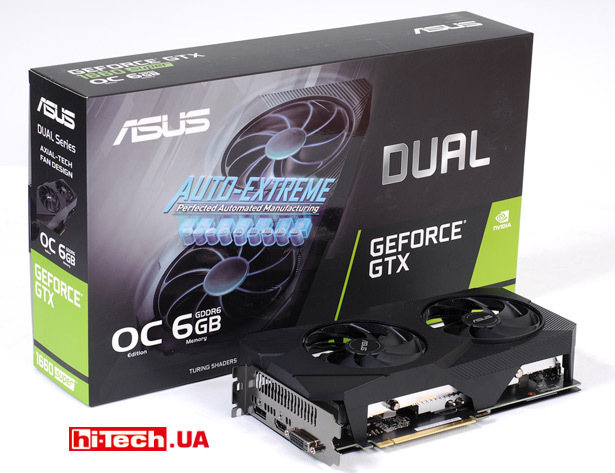
ASUS Dual GeForce GTX 1660 SUPER EVO OC
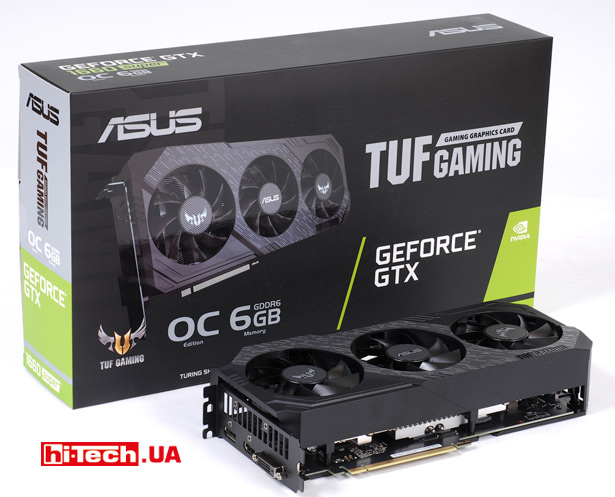
ASUS TUF Gaming X3 GeForce GTX 1660 SUPER OC
But first, I would like to note a rather unusual method of packaging video cards. The boards are attached to the cardboard base with film. This is the first time we’ve seen this option from ASUS.
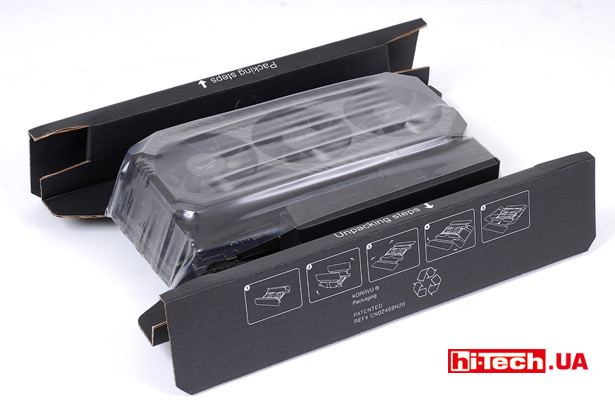
Manufacturers have long been free to make even mid-level video cards quite large. Both models will take up more than two expansion slots on the motherboard.
The difference in the number of cooling system fans is immediately noticeable.
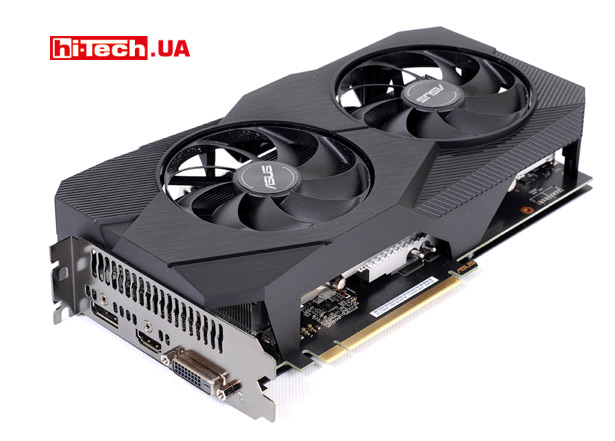
ASUS Dual GeForce GTX 1660 SUPER OC EVO
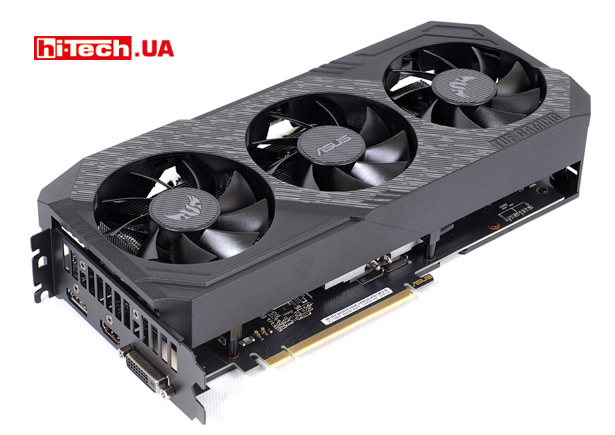
ASUS TUF Gaming X3 GeForce GTX 1660 SUPER OC
In both cases, a proprietary CO with an aluminum radiator penetrated by two heat pipes is used.
These tubes directly (via thermal paste, of course) touch the GPU.
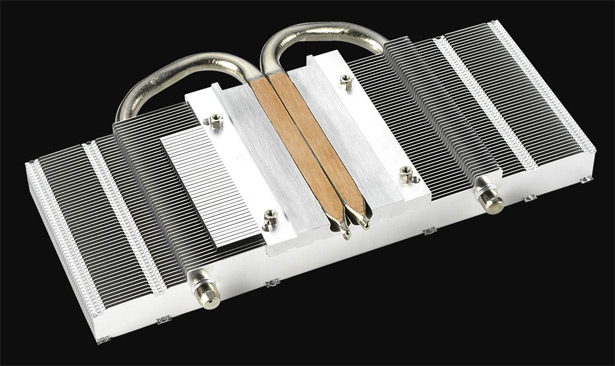
Upon careful inspection, you notice that both the three-fan ASUS TUF Gaming X3 GeForce GTX 1660 SUPER OC and the two-fan ASUS Dual GeForce GTX 1660 SUPER EVO OC (DUAL-GTX1660S-O6G-EVO) have the same radiator.
It is strange that the branded SOs received different names. TUF Gaming X3 GeForce GTX 1660 SUPER OC is DirectCU III, and ASUS Dual GeForce GTX 1660 SUPER EVO OC is DirectCU II.
In the description of the models, the manufacturer provides various interesting facts.
- ASUS TUF Gaming X3 GeForce GTX 1660 SUPER OC (TUF 3-GTX1660S-O6G-GAMING)
- ASUS TUF Gaming X3 GeForce GTX 1660 SUPER OC (TUF 3-GTX1660S-O6G-GAMING)
- ASUS TUF Gaming X3 GeForce GTX 1660 SUPER OC (TUF 3-GTX1660S-O6G-GAMING)
- ASUS TUF Gaming X3 GeForce GTX 1660 SUPER OC (TUF 3-GTX1660S-O6G-GAMING)
For example, the TUF Gaming video card claims IP5X dust protection and the use of a special lubricant with low volatility, which should last longer than usual.
In addition, the boards undergo a 144-hour stability test before packaging.
ASUS Dual GeForce GTX 1660 SUPER OC EVO has its own trump cards. It features advanced Axial-tech turntables with a smaller central part. Accordingly, it became possible to make the blades longer with the same fan diameter.
- ASUS Dual GeForce GTX 1660 SUPER EVO OC (DUAL-GTX1660S-O6G-EVO)
- ASUS Dual GeForce GTX 1660 SUPER EVO OC (DUAL-GTX1660S-O6G-EVO)
- ASUS Dual GeForce GTX 1660 SUPER EVO OC (DUAL-GTX1660S-O6G-EVO)
- ASUS Dual GeForce GTX 1660 SUPER EVO OC (DUAL-GTX1660S-O6G-EVO)
What is important is that only the ASUS Dual GeForce GTX 1660 SUPER EVO OC from the presented pair can automatically completely stop the fans if the GPU temperature drops below the set one.
An additional plate on the back of video cards is designed to mechanically protect the devices.
The set of connectors, consisting of HDMI, DisplayPort and DVI (all 1 pc.), is not rich, but for the vast majority of users it will be enough.
There is backlighting, but it’s modest. Both video cards have a small glowing stripe on the side. There is no backlight control provided.
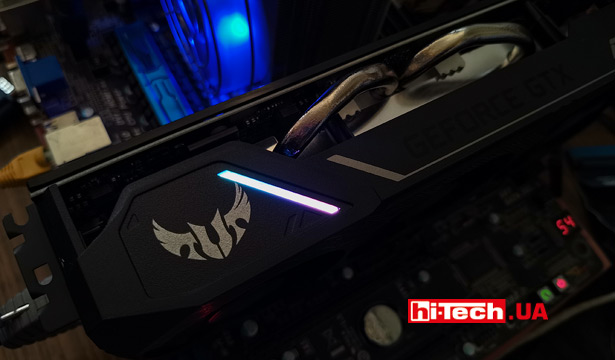
Backlight ASUS TUF Gaming X3 GeForce GTX 1660 SUPER OC

Backlight ASUS Dual GeForce GTX 1660 SUPER EVO OC
As expected, the OC prefix in the name of these video cards indicates slightly increased frequencies. ASUS has exactly the same video cards in its assortment, but without the OC prefix.
Oddly enough, the ASUS TUF Gaming X3 GeForce GTX 1660 SUPER OC and ASUS Dual GeForce GTX 1660 SUPER EVO OC video cards, which are so different in appearance, have frequencies that are identical.
This is 1530 MHz base and 1830 Boost frequencies for the GPU and a resulting frequency of 14002 MHz for video memory.
You can compare these values with the reference frequencies in the table above.
Heat and noise
More fans mean better cooling? This is not the case with this pair of video cards.
Under load, the temperatures of the GPUs of the presented video cards stabilized at approximately the same level, 63 and 64 °C, respectively, but the fan rotation speed of the three-fan ASUS TUF Gaming X3 was even slightly higher than that of the two-fan ASUS Dual (about 1590 rpm . versus 1750 rpm).
The fact is thatthe radiator used (remember that video cards have the same radiators) is too short for the 3-fan version of the video card. As a result, part (approximately 30% by eye) of the air forced by the outer fans does not reach the radiator fins.
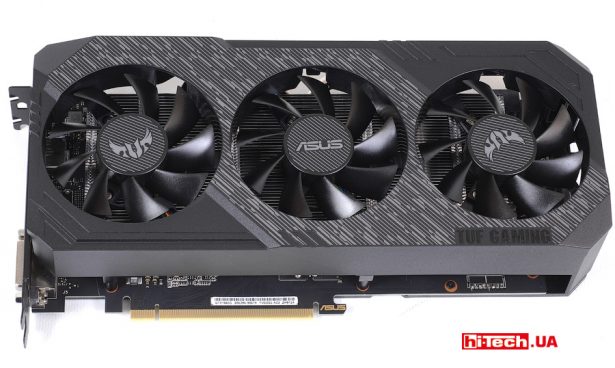
If you look closely, you can see that the side fans protrude beyond the edges of the radiator on the ASUS TUF Gaming X3 GeForce GTX 1660 SUPER OC video card
In addition, ASUS Dual uses larger fans.
It must be said that the maximum GPU temperatures shown are quite low, which indicates the high cooling efficiency of both models.
The video cards, of course, are not as quiet as some other models, where fan speeds of 1000 rpm are sufficient for cooling.
Their noise level can be called moderate, at the same time, the ASUS TUF Gaming X3 GeForce GTX 1660 SUPER OC is slightly louder than its dual-fan sister.
Performance
Test platform configuration:
- Processor: Intel Core i7-3770K, overclocked to 4.3 MHz
- Motherboard: Biostar Hi-Fi Z77X
- RAM capacity: 4×4 GB DDR3 1600
- Storage: SSD (system), HDD
- Operating system: Windows 10 Pro 64 bit
- NVIDIA driver used for video cards based on NVIDIA GeForce GTX 1660 Super: GeForce GeForce 441.08
- NVIDIA driver used for video cards based on NVIDIA GeForce GTX 1060 Ti, GeForce GTX 1070: GeForce 419.35
Test results
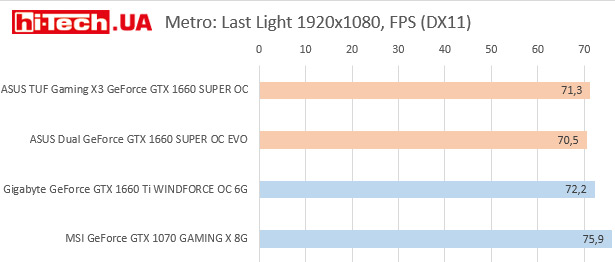
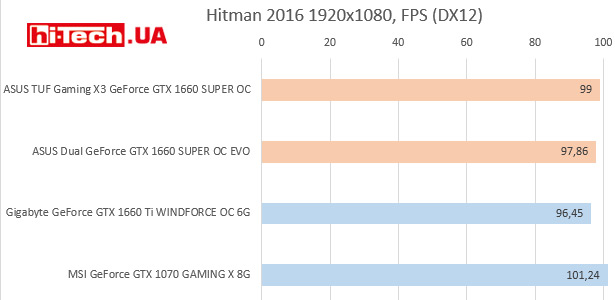
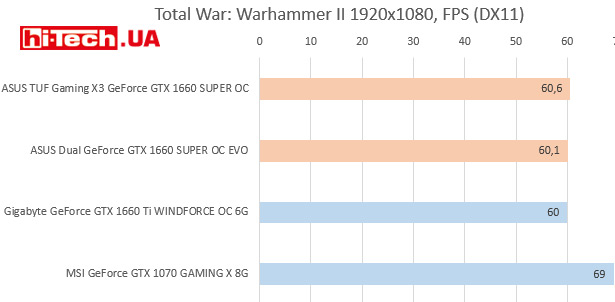
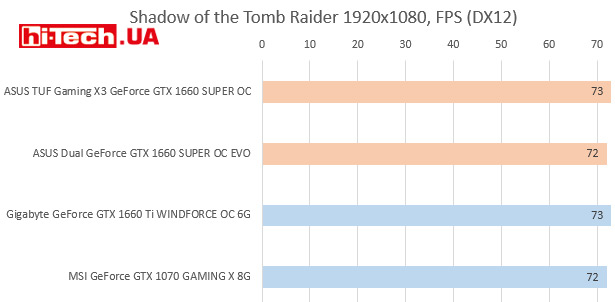
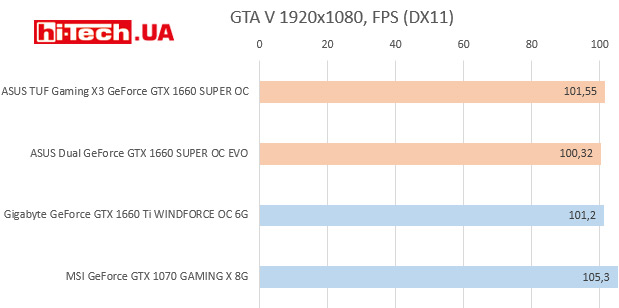
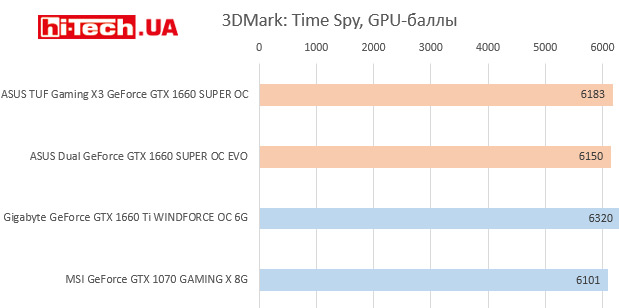
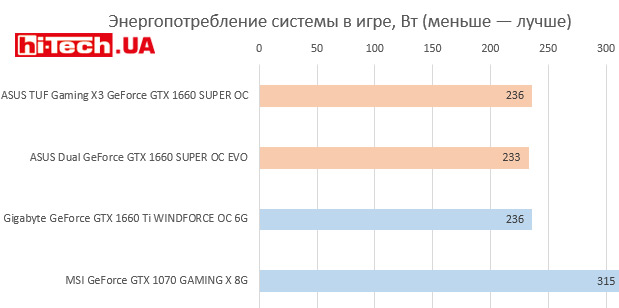
Despite identical frequencies, in tests we recorded a very slight performance advantage of the ASUS TUF Gaming X3 GeForce GTX 1660 SUPER OC over the ASUS Dual GeForce GTX 1660 SUPER OC EVO.
But the difference is so tiny that it definitely won’t be noticeable.
The transition to a new type of memory allowed NVIDIAGeForce GTX 1660 Super video cards, in general, to come close in speed to GTX 1660 Ti (compared with Gigabyte GeForce GTX 1660 Ti WINDFORCE OC 6G).
This is also approximately the same level of performance as demonstrated by the previous generation GTX 1070 video cards (the tests used the very advanced MSI GeForce GTX 1070 GAMING X 8G).
Unfortunately, it was not possible to directly compare the GTX 1660 Super with the regular GTX 1660. But, knowing the performance level of the GTX 1660, we can say that the new GTX 1660 Super, which differs only in the new type of memory, is about 10-15% ahead of it.
In terms of power consumption, the GTX 1660 SUPER and GTX 1660 Ti are on the same level and demonstrate higher energy efficiency compared to the previous generation GTX 1070 model.
The performance of video cards based on NIVIDIA GeForce 1660 SUPER is sufficient for demanding modern games when choosing high quality graphics and Full HD resolution. When using a higher 2K resolution, you will sometimes have to sacrifice rendering quality in order to obtain a more comfortable FPS level.
Conclusions
The video cards based on the GTX 1660 Super from ASUS presented in the test are representatives of far from the most advanced lines available in the ASUS arsenal.
However, these are high-quality devices, provided with proprietary efficient cooling systems.
A nice bonus is slightly higher frequencies and a luminous element on the body.
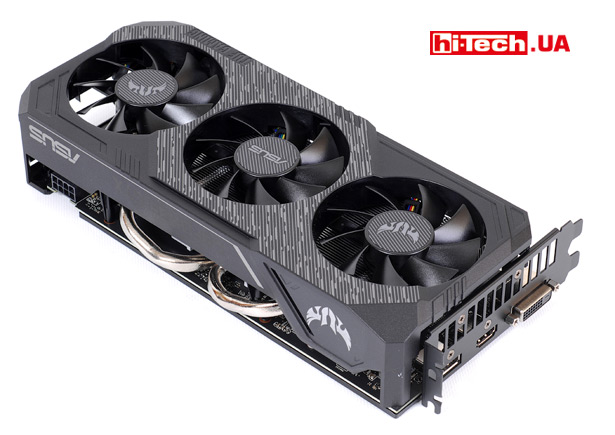
ASUS TUF Gaming X3 GeForce GTX 1660 SUPER OC
Choosing between ASUS TUF Gaming X3 GeForce GTX 1660 SUPEROC and ASUS Dual GeForce GTX 1660 SUPER EVO OC, we prefer the model ASUS Dual.
It is the only one of this pair that can completely stop the fans and has a more optimal cooling system, despite the smaller number of fans.
It is curious that ASUS Dual also turned out to be slightly cheaper than its “colleague”.
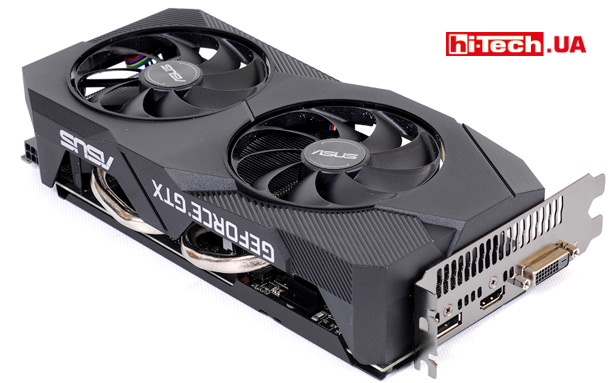
ASUS Dual GeForce GTX 1660 SUPER EVO OC
Video cards based on NVIDIA GeForce GTX 1660 Super are already available for sale. Our price, especially considering that this is the very start of sales, is expectedly very far from the recommended $229.
Knowing the level of performance and taking into account current prices, you can analyze how these GTX 1660 Super options will be preferable to solutions based on the GTX 1660 and GTX 1660 Ti.
ASUS TUF Gaming X3 GeForce GTX 1660 SUPER OC (TUF 3-GTX1660S-O6G-GAMING) characteristics
| Model | NVIDIA GeForce GTX 1660 Super |
| Interface | PCI Express 3.0 x16 |
| GPU | TU116 |
| Technical process | 12 nm |
| Video memory | 6 GB, GDDR6 |
| Memory bus | 192 bit |
| GPU frequency | 1830 (boost) MHz |
| Resulting memory frequency | 14,000 MHz |
| Outputs | HDMI, DisplayPort, DVI |
| Additional power connector | 8 Pin |
| Energy consumption | 125 W |
| Supplier | ASUS Representative Office |
| Price | $332 |
RatingASUS TUF Gaming X3 GeForce GTX 1660 SUPER OC:
+ efficient cooling system
+ good level of performance
+ increased GPU frequencies
+ low power consumption considering the performance level
- the backlight is very modest
- large dimensions
- there is no fan stop mode
ASUS Dual GeForce GTX 1660 SUPER EVO OC (DUAL-GTX1660S-O6G-EVO) characteristics
| Model | NVIDIA GeForce GTX 1660 Super |
| Interface | PCI Express 3.0 x16 |
| GPU | TU116 |
| Technical process | 12 nm |
| Video memory | 6 GB, GDDR6 |
| Memory bus | 192 bit |
| GPU frequency | 1830 (boost) MHz |
| Resulting memory frequency | 14,000 MHz |
| Outputs | HDMI, DisplayPort, DVI |
| Additional power connector | 8 Pin |
| Energy consumption | 125 W |
| Supplier | ASUS Representative Office |
| Price | $324 |
Rating ASUS Dual GeForce GTX 1660 SUPER EVO OC:
+ efficient cooling system
+ good level of performance
+ increased GPU frequencies
+ low power consumption considering the performance level
+ complete fan stop mode
- the backlight is very modest
- large dimensions
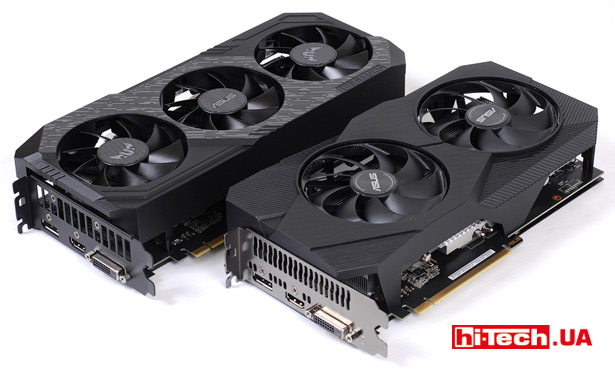
Read also:
- Review of the ASUS Dual GeForce RTX 2060 SUPER EVO OC video card. Really “super”?
- Review of video cards based on NVIDIA GTX 1650 series MSI VENTUS and GAMING. Appearances are deceiving
- Comparative test of NVIDIA GTX 1660 Ti video cards from ASUS, MSI, Gigabyte and Inno3D. Did you remove the excess?
- Review and comparison of video cards based on NVIDIA RTX 2070 from ASUS, Gigabyte, Inno3D and MSI
Engineer of the Test Laboratory
Don't miss interesting news
Subscribe to our channels and read announcements of high-tech news, tes
Oppo A6 Pro smartphone review: ambitious

Creating new mid-range smartphones is no easy task. Manufacturers have to balance performance, camera capabilities, displays, and the overall cost impact of each component. How the new Oppo A6 Pro balances these factors is discussed in our review.
Editor’s Choice 2025. Best devices of the year by hi-tech.ua

The best gaming laptops, mice for work, gaming keyboards, smartphones, and wireless headphones of 2025. Among them, we will highlight the most interesting ones and those that we can recommend buying.
YouTube will be completely blocked in russia YouTube
Russian authorities continue to restrict citizens’ access to independent sources of information. After blocking Instagram, Facebook, WhatsApp, Discord, Viber, and even the game Roblox
EU will not ban internal combustion engine cars after 2035 car law
European Union has revised its approach to regulating the sale of cars with internal combustion engines and abandoned the idea of a complete ban.





